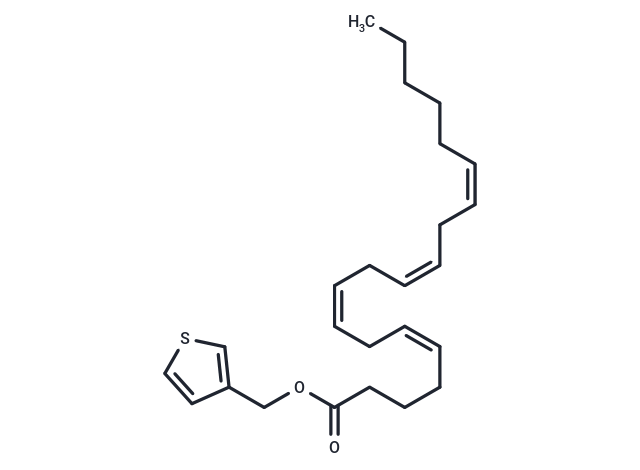 Your shopping cart is currently empty
Your shopping cart is currently empty

Anandamide (arachidonoyl ethanolamide; AEA) is an endogenous lipid with cannabinergic activity; along with 2-arachidonoyl glycerol, it forms part of the endocannabinoid system. AEA undergoes reuptake into neurons by a facilitated process. Controversy exists as to whether there is a specific AEA transporter, or instead the uptake process is simply driven by hydrolysis of AEA by intracellular fatty acyl amide hydrolase (FAAH). CAY10412 is an analog of AEA that has no intrinsic binding affinity for either CB1 or CB2 receptors. It is a potent inhibitor of AEA reuptake in U937 lymphoma cells, with an IC50 of 3 μM. CAY10412 could be a useful tool for distinguishing the competing transporter theories. The pharmacology of CAY10412 is largely unexplored; it may enhance endocannabinoid signalling by augmenting endocannabinoid concentrations.

| Pack Size | Price | USA Warehouse | Global Warehouse | Quantity |
|---|---|---|---|---|
| 5 mg | $137 | 35 days | 35 days | |
| 10 mg | $258 | 35 days | 35 days | |
| 50 mg | $1,050 | 35 days | 35 days | |
| 100 mg | $1,830 | 35 days | 35 days |
| Description | Anandamide (arachidonoyl ethanolamide; AEA) is an endogenous lipid with cannabinergic activity; along with 2-arachidonoyl glycerol, it forms part of the endocannabinoid system. AEA undergoes reuptake into neurons by a facilitated process. Controversy exists as to whether there is a specific AEA transporter, or instead the uptake process is simply driven by hydrolysis of AEA by intracellular fatty acyl amide hydrolase (FAAH). CAY10412 is an analog of AEA that has no intrinsic binding affinity for either CB1 or CB2 receptors. It is a potent inhibitor of AEA reuptake in U937 lymphoma cells, with an IC50 of 3 μM. CAY10412 could be a useful tool for distinguishing the competing transporter theories. The pharmacology of CAY10412 is largely unexplored; it may enhance endocannabinoid signalling by augmenting endocannabinoid concentrations. |
| Synonyms | CAY10412 |
| Molecular Weight | 400.62 |
| Formula | C25H36O2S |
| Cas No. | 390824-17-6 |
| Smiles | C(OC(CCC/C=C\C/C=C\C/C=C\C/C=C\CCCCC)=O)C=1C=CSC1 |
| Storage | Powder: -20°C for 3 years | In solvent: -80°C for 1 year | Shipping with blue ice/Shipping at ambient temperature. | |||||||||||||||||||||||||||||||||||
| Solubility Information | Ethanol: 30 mg/mL (74.88 mM), Sonication is recommended. DMSO: 20 mg/mL (49.92 mM), Sonication is recommended. DMF: 30 mg/mL (74.88 mM), Sonication is recommended. Ethanol:PBS (pH 7.2) (1:3): 100 μg/mL, Sonication is recommended. | |||||||||||||||||||||||||||||||||||
Solution Preparation Table | ||||||||||||||||||||||||||||||||||||
DMSO/Ethanol/DMF
Ethanol/DMF
| ||||||||||||||||||||||||||||||||||||
| Size | Quantity | Unit Price | Amount | Operation |
|---|

Copyright © 2015-2026 TargetMol Chemicals Inc. All Rights Reserved.